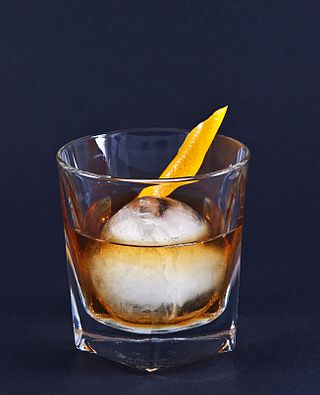
The old fashioned is a cocktail made by muddling sugar with bitters and water, adding whiskey or sometimes brandy, and garnishing with an orange slice or zest and a cocktail cherry. It is traditionally served with ice in an old fashioned glass.
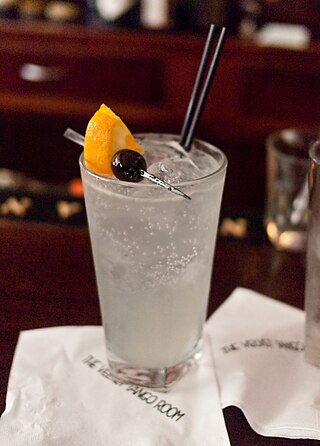
The Tom Collins is a Collins cocktail made from gin, lemon juice, sugar, and carbonated water. First memorialized in writing in 1876 by Jerry Thomas, "the father of American mixology", this "gin and sparkling lemonade" drink is typically served in a Collins glass over ice. A non-alcoholic "Collins mix" mixer is produced, enjoyed by some as a soft drink.
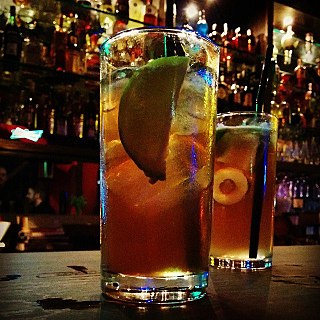
The Long Island iced tea, or Long Island ice tea, is an IBA official cocktail, typically made with vodka, tequila, light rum, triple sec, gin, and a splash of cola. Despite its name, the cocktail does not typically contain iced tea, but is named for having the same amber hue as iced tea.

A margarita is a cocktail consisting of tequila, triple sec, and lime juice. Some margarita recipes include simple syrup as well and are often served with salt on the rim of the glass. Margaritas can be served either shaken with ice, without ice, or blended with ice. Most bars serve margaritas in a stepped-diameter variant of a cocktail glass or champagne coupe called a margarita glass. The margarita is one of the world's most popular cocktails and the most popular tequila-based cocktail.
A blended whiskey is the product of blending different types of whiskeys and sometimes also neutral spirits, colorings, and flavorings. It is generally the product of mixing one or more higher-quality straight or single malt whiskey with less expensive spirits and other ingredients. This typically allows for a lower priced finished product, although expensive "premium" varieties also exist.

The negroni is a cocktail, made of equal parts gin, vermouth rosso, and Campari, generally served on the rocks, and commonly garnished with an orange slice or orange peel. It is considered an apéritif.

Arrack is a distilled alcoholic drink typically produced in India, Sri Lanka and Southeast Asia, made from the fermented sap of coconut flowers or sugarcane, and also with grain or fruit depending upon the country of origin. It is sometimes spelled arak, or simply referred to as 'rack or 'rak. It is not to be confused with the anise-flavored distilled spirit called arak or araq. In many parts of India arrack is colloquially known as "desi daru".
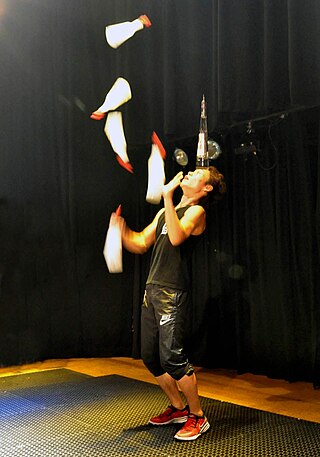
Flair bartending is the practice of bartenders entertaining guests, clientele or audiences with the manipulation of bar tools and liquor bottles in tricky, dazzling ways. Used occasionally in cocktail bars, the action requires skills commonly associated with jugglers. It has become a sought-after talent among venue owners and marketers to help advertise a liquor product or the opening of a bar establishment. Competitions have been sponsored by liquor brands to attract flair bartenders, and some hospitality training companies hold courses to teach flair techniques.

Various unique terminology is used in bartending.
The Washington State Liquor and Cannabis Board, formerly the Washington State Liquor Control Board, is an administrative agency of the State of Washington. The Liquor and Cannabis Board is part of the executive branch and reports to the Governor. The board's primary function is the licensing of on and off premises establishments which sell any type of alcohol, and the enforcement and education of the state's alcohol, tobacco, and cannabis laws.

Mekhong (แม่โขง) is Thailand's first domestically produced branded golden spirit. It is also known as "The Spirit of Thailand".
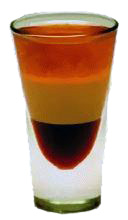
The B-52 cocktail is a layered shot composed of coffee liqueur (Kahlúa), Irish cream, and Grand Marnier. When prepared properly, the ingredients separate into three distinctly visible layers.

A flaming drink is a cocktail or other mixed drink that contains flammable, high-proof alcohol, which is ignited before consumption. The alcohol may be an integral part of the drink, or it may be floated as a thin layer across the top of the drink. The flames are mostly for dramatic flair. However, in combination with certain ingredients, the flavor of the drink is altered. Some flavors are enhanced, and the process may impart a toasted flavor to some drinks.

As of 2006 most distilled spirits labelled as "whisky" in India were a form of Indian-made foreign liquor, commonly blends based on neutral spirits that are distilled from fermented molasses with only a small portion consisting of traditional malt whisky, usually about 10 to 12 percent. Outside India, such a drink would more likely be labelled a rum. According to the Scotch Whisky Association's 2013 annual report, unlike in the European Union (EU), "there is no compulsory definition of whisky in India, and the Indian voluntary standard does not require whisky to be distilled from cereals or to be matured. Very little Indian 'whisky' qualifies as whisky in the EU owing to the use of molasses or neutral alcohol, limited maturation and the use of flavourings. Such spirits are, of course, considerably cheaper to produce than genuine whisky." Such molasses-based blends made up 90 percent of the spirits consumed as "whisky" in India in 2004, although whisky wholly distilled from malt and other grains, was also manufactured and sold. By 2004 shortages of wheat had been overcome and India was one of the largest producers. Amrut, the first single malt whisky produced in India, was launched in Glasgow, Scotland in 2004. After expanding in Europe it was launched in India in 2010.
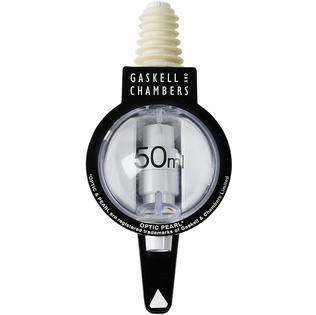
Alcoholic spirits measures are instruments designed to measure exact amounts or shots of alcoholic spirits.

Sazerac Company, Inc. is a privately held American alcoholic beverage company headquartered in Metairie in the metropolitan area of New Orleans, Louisiana, but with its principal office in Louisville, Kentucky. The company is owned by billionaire William Goldring and his family. As of 2017, it operated nine distilleries, had 2,000 employees, and operated in 112 countries. It is one of the two largest spirits companies in the United States, with annual revenue of about $1 billion made from selling about 300 beverage brands.
Eryn Reece is an American bartender. She is the bar director for Banzabar and Freemans Restaurant, both in New York City. In 2013, Reece was named Speed Rack National Champion. In 2014, The Daily Meal named her one of the top 25 bartenders in the United States. Reece has been profiled in, and her work featured in, PUNCH, The Daily Beast, Maxim, WPIX, The Spirits Business, Thrillist, and other media outlets.
Top-shelf liquor is a term used in marketing to describe higher-priced alcoholic beverages, typically stored on the top shelves within bars. This contrasts to a "rail" or well drink, which are lower cost beverages typically stored on the lower shelves of the bartender's rack.
















